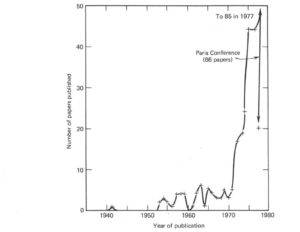In presenting written technical information in academic papers and presentations, including in geosynthetic papers, as well as conference proceedings and presentations, it is established practice for the author to attribute references, data, charts, tables, graphs, photographs, illustrations and concepts back to the initial originator/developer, who under law is the copyright holder to the work simply by the act of creating the work. Even if one slightly changes or modifies the source, it is wise to reference the original document but then add the word “modified” to the reference. This also holds for information/images taken from the internet, webinars, brochures, manufacturers’ websites, etc. All should be attributed to the original source. If you would like to see a model paper of the above type of attribution and referencing, see Professor Robert D. Holtz’s 46th Terzaghi Lecture, which has been published by the American Society of Civil Engineers (ASCE). (You can purchase the text of the lecture from ASCE at https://tinyurl.com/HoltzLecture.) Holtz even references nonwritten verbal attributions, such as “J. Smith, personal communication, 2015.”
The Visual Resources Association (VRA), which describes itself on its website as “a multidisciplinary organization dedicated to furthering research and education in the field of image management within the educational, cultural heritage, and commercial environments,” has made available a useful “Statement on the Fair Use of Images for Teaching, Research, and Study,” which is available online at https://tinyurl.com/VRAFairUse. In it, the VRA suggests those using images and other copyrighted visual material for academic purposes should attribute the image to the copyright holder to help establish “good faith” under copyright law’s fair use standards. The VRA said that although attribution is not required under copyright law, not attributing such usage in academic papers and presentations increases the exposure of an author of an academic paper or presentation to a potential copyright infringement lawsuit.
Note that the copyright law standards are different for uses in academic papers and presentations than they are for formal publications that are sold and, therefore, have a commercial value, such as Geosynthetics magazine. The magazine needs to obtain written copyright clearance from the copyright holder to publish any image not originated by the author of an article, including all images taken from the internet.
All of this said, the original sources of old papers, documents, photos, etc., can easily get lost over time and may, thus, be unrecoverable. Lately, I have been writing “author unknown” or “source unknown” when an original copyright holder cannot be located, which eases my mind somewhat in this regard.
A related problem is not having a geosynthetic reference storehouse, aka, a library of geosynthetics information. Insofar as geosynthetics are concerned, publications go back well before the first conference

proceedings in Paris in 1977, as shown in Figure 1. Since 1977, the geosynthetic reference literature has exploded in quantity. My rough estimate of published geosynthetics papers is that it probably approaches 100,000 today, including many in languages other than English. Retrieval is certainly a challenge for all academic authors. By the way, the only geosynthetics keyword search available to my knowledge (other than by a specific journal for its specific published papers) is by the Geosynthetic Institute (GSI), and it is proprietary to members. Incidentally, there are about 35,000 citations included, and it is now available at a nominal cost for non-GSI members (see www.geosynthetic-institute.org/keywordpay.html).
Continuing further with regard to access to references, we are losing, in my opinion, a wealth of information by the manner in which some geosynthetics journals are published and conference proceedings are disseminated. Most geosynthetics journals are not printed but are published online. Thus, papers are in the cloud and retrieval is controlled and often expensive. Similarly, organizers rarely give out conference proceedings in hard copies any longer, and they also do not even give CDs or memory sticks. Typically, such information is also available only online.
In closing, we are missing a wealth of past information due to the modern methods of journal publications and particularly conference proceedings. When the requisite references are located and available, attribution of past work does nothing to detract from one’s personal work. To the contrary, it enhances the author’s prestige and knowledge in the reader’s/reviewer’s mind. Going forward, let us (author included) all do better in this regard.
 TEXTILES.ORG
TEXTILES.ORG


